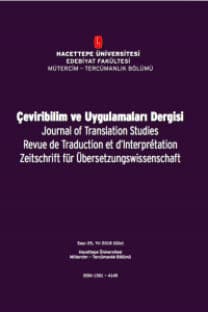Terry Pratchett’ın Wyrd Sisters Adlı Eserinde Yer Alan Anıştırmaların Metinlerasılık Aracılığıyla Okunması ve Türkçe Çevirilerinin Değerlendirilmesi
metinlerarasılık, anıştırma, çeviri stratejileri, Wyrd Sisters, yazın çevirisi
Reading The Allusions in Terry Pratchett’s Wyrd Sisters Through the Lens of Intertextuality and Evaluating their Turkish Translations
___
- Aktulum, K. (2011). Metinlerarasılık / Göstergelerarasılık. Kanguru.
- Author more honored abroad. (1984, June 20) The Canberra Times. Retrieved December 21, 2022, from https://trove.nla.gov.au/newspaper/article/127003994
- Bahrami, N. (2011). Strategies used in the translation of allusions in Hafiz Shirazi’s poetry. Journal of Language and Culture, 3(1), 1-9. http://doi.org/10.5897/JLC11.058
- Bakhtin, M. (1981). The dialogic imagination: four essays (C. Emerson & M. Holquist, Trans.). University of Texas Press.
- Kuleli, M. (2014). Intertextual allusions and evaluation of their translation in the novel Silent House by Orhan Pamuk. Procedia-Social and Behavioral Sciences, 158, 206-213. https://doi.org/10.1016/j.sbspro.2014.12.075
- Kuleli, M. (2018). Intertextuality in translation: Analysis of intertextual signs and evaluation of translation of a short story. International Journal of Languages’ Education and Teaching, 6(3), 317-330. https://doi.org/10.18298/ijlet.3157
- Kristeva, J. (1986). Word, dialogue and novel. In J. Kristeva (Ed), The Kristeva reader (pp.35-61.) Columbia University Press.
- Leppihalme, R. (1997). Culture bumps: An empirical approach to the translation of allusions. Multilingual matters.
- Lochrie, D. W. (1992). A critical evaluation of the current performance versions of Musorgsky’s Night on Bald Mountain, based on the history and content of Musorgsky’s original extant versions and a new orchestration of Night on Bald Mountain [Unpublished doctoral thesis]. Ohio State University.
- Mishra, V. (1985). Text, textuality and interpretation: an interview with Michael Riffaterre. Southern Review, 18 (1), 109-119. https://researchportal.murdoch.edu.au/esploro/outputs/journalArticle /Text-textuality-and-interpretation-An- interview/991005544009707891
- Mustonen, M. (2016). Translating wordplay: A case study on the translation of wordplay in Terry Pratchett’s Soul Music [Unpublished master’s thesis]. University of Turku.
- Pratchett, T. (1988). Wyrd sisters. Victor Gollanz Ltd.
- Pratchett, T. (2016). Ucube kocakarılar. Niran Elçi (Çev.). Tudem
- Pullinen, V. (2016). Intertextuality as a source of humour in Terry Pratchett’s novels [Unpublished master’s thesis]. University of Jyväskylä.
- Riffaterre, M. (1978). Semiotics of poetry. Indiana University Press. https://doi.org/10.2979/SemioticsofPoetry
- Riffaterre, M. (1990). Fictional truth. The Johns Hopkins University Press.
- Shakespeare, W. (1905). The complete works of William Shakespeare. Oxford University Press.
- Shakespeare, W. (1999). The Tragedy of Macbeth (Orhan Burian, Trans.). Çağdaş Yayıncılık.
- Southgate, M. T. (1998). Venus Anadyomene. JAMA, 279(11), 814-814.
- Tekalp, S. (2020). A study on the self-translation of allusions in Bit Palas By Elif Shafak. New Voices in Translation Studies, 22, 117-138. https://newvoices.arts.chula.ac.th/index.php/en/article/view/421
- Türk Edebiyatı İsimler Sözlüğü. (n.d.). Elçi, Niran. In Türk Edebiyatı İsimler Sözlüğü Retrieved June 21, 2022 from https://teis.yesevi.edu.tr/madde- detay/elci-niran
- Yayın Aralığı: Yılda 2 Sayı
- Başlangıç: 1991
- Yayıncı: Hacettepe Üniversitesi
“Çeviri” ve “Arada Kalmışlık” Metaforu Olarak “Kafes”
Sözlü Çeviri Eğitiminde Sınıf İçi Uygulamalar ve Yaklaşımlar
Sığırcı, İlhami. (2022). Çeviri Felsefesi. Nobel. 178 s. ISBN: 978-625-427-116-8
Efsuncu Baba Romanı Işığında Türkiye'de Diliçi Çeviri
Yemek Yazını Çevirisi Alanındaki Bir Yayıncının Habitusu ve Sermayesi: Güzin Yalın Örneği
Çeviribilimde Jiří Levý’nin Oyun Kuramı Temelinde Yanıltmaca Çevirileri
Çeviri Eğitiminde Kültürlerarası İletişim Edinci Geliştirme: Üstbilişsel bir Yaklaşım
